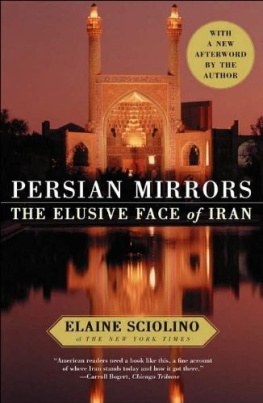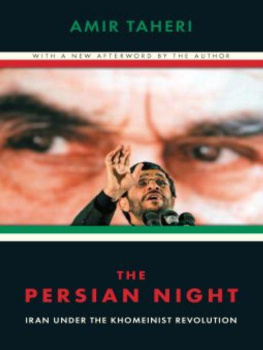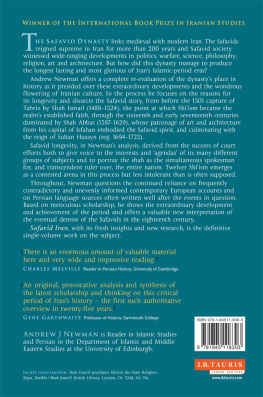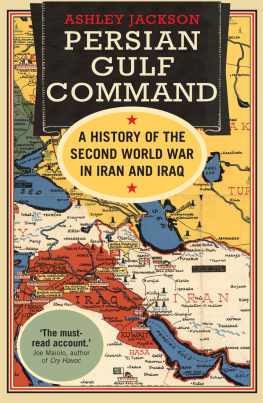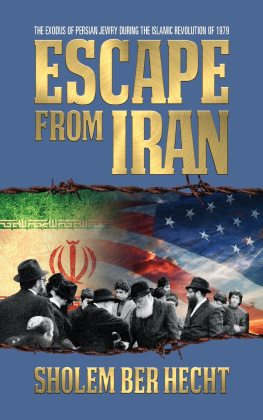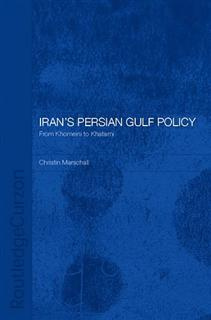ELAINE SCIOLINO - Persian Mirrors: The Elusive Face of Iran
Here you can read online ELAINE SCIOLINO - Persian Mirrors: The Elusive Face of Iran full text of the book (entire story) in english for free. Download pdf and epub, get meaning, cover and reviews about this ebook. year: 2000, publisher: FREE PRESS, genre: Detective and thriller. Description of the work, (preface) as well as reviews are available. Best literature library LitArk.com created for fans of good reading and offers a wide selection of genres:
Romance novel
Science fiction
Adventure
Detective
Science
History
Home and family
Prose
Art
Politics
Computer
Non-fiction
Religion
Business
Children
Humor
Choose a favorite category and find really read worthwhile books. Enjoy immersion in the world of imagination, feel the emotions of the characters or learn something new for yourself, make an fascinating discovery.
- Book:Persian Mirrors: The Elusive Face of Iran
- Author:
- Publisher:FREE PRESS
- Genre:
- Year:2000
- Rating:3 / 5
- Favourites:Add to favourites
- Your mark:
- 60
- 1
- 2
- 3
- 4
- 5
Persian Mirrors: The Elusive Face of Iran: summary, description and annotation
We offer to read an annotation, description, summary or preface (depends on what the author of the book "Persian Mirrors: The Elusive Face of Iran" wrote himself). If you haven't found the necessary information about the book — write in the comments, we will try to find it.
Persian Mirrors: The Elusive Face of Iran — read online for free the complete book (whole text) full work
Below is the text of the book, divided by pages. System saving the place of the last page read, allows you to conveniently read the book "Persian Mirrors: The Elusive Face of Iran" online for free, without having to search again every time where you left off. Put a bookmark, and you can go to the page where you finished reading at any time.
Font size:
Interval:
Bookmark:

ALSO BY ELAINE SCIOLINO
The Outlaw State
SADDAM HUSSEINS QUEST FOR POWER
AND THE GULF CRISIS

THE FREE PRESS
A division of Simon & Schuster, Inc.
1230 Avenue of the Americas
New York, New York 10020
Visit us on the World Wide Web:
http://www.SimonSays.com
Copyright 2000 by Elaine Sciolino
All rights reserved, including the right of reproduction in whole or in part in any form.
THE FREE PRESS and colophon are registered trademarks of Simon & Schuster, Inc.
ISBN-10: 0-7432-1453-6
ISBN-13: 978-0-7432-1453-7
The author gratefully acknowledges permission from the following sources to reprint material in their control: Arash Forouhar for the text of an unpublished poem by his mother, Parvaneh Forouhar. IBEX Publishers for a poem from The Hafez Poems of Gertrude Bell, 1995 by IBEX Publishers, Bethesda, MD. R. D. McChesney, the editor of Iranian Studies, for the text of poems by Ruhollah Khomeini found in Five Mystical Ghazals by the Ayatollah Khomeini in The Journal of the Society for Iranian Studies: Selections from the Literature of Iran, 19771997, special issue, volume 30, No. 34, Summer/Fall 1997. Universal Press Syndicate for the text from a Doonesbury cartoon of May 30, 1980, 1980 by G. B. Trudeau. Zagros Press, Princeton, NJ, for an excerpt from The Iraj Mirja poem Aref Nameh found in The Poetics of Hijab in the Satire of Iraj Mirza, in Iran and Iranian Studies: Essays in Honor of Iraj Afshar, edited by Kambiz Eslami, 1998 by Zagros Press.
In memory of Maynard Parker
P E R S I A N M I R R O R S
Reflections and Distortions
I NEVER WENT to Iran for the nightlife.
I went for a revolution, a war, and an embassy seizure. And I kept going back.
For much of my career, I was what they call in the newspaper business a hard-news reporter. That meant I covered breaking events. I wrote about what I saw on the streets. I didnt do parties.
Yet here I was, late on a Friday night in the heart of Kurdistan province, at a raucous wedding party that didnt want to end. A young woman in a tight red dress and lipstick to match whipped a long pink chiffon scarf from her head to reveal waist-length curls. But it was her shoulders and hips that captivated the crowd. The shoulders and hips didnt stop rotating as she pranced hard on a concrete patio that had become a dance floor some hours before. She thrust her head back and her bosom forward, waving her scarf in the air as she beckoned others to join her.
The clerics had made the head scarf the national symbol of womens purity, and here was a lady in red, using it as a lure to pull others to dance with her. I couldnt quite figure out how she moved all those body parts in so many different directions at the same time. But all the rotating and thrusting and scarf-waving worked, and soon there were two dozen Kurdish men in balloon pants and waist-length jackets on the dance floor with her. They linked arms in a wide circle. Now it was their turn to sway and thrust and kick and prance for the crowd. It looked like a frenzied rendition of the hora.
Ayatollah Ruhollah Khomeini, the stern cleric who had fathered Irans revolution a generation before, once said that there is no fun in Islam. He would have been astonished at what he saw.
That evening, the dancing wasnt the only surprise. There was the way the women were dressed, and not just the young ones like the lady in red. We were in an open garden into which outsiders could peek, but here were two hundred women in mixed company breaking the law and revealing their hairlacquered, teased, curled, dyed, twisted, braided, and frostedin acts of vanity and defiance. Some of the women wore traditional Kurdish costumes, in jewel colors and layers of sequined lace bodices, flowered sashes, flowing satin skirts, necklaces of shiny plastic beads. One woman, who turned out to be the mother of the groom, resembled an aging fairy godmother: a gold lace skirt over petticoats, a gold satin vest, a gold chiffon blouse, gold-streaked hair, and matching gold earrings and bangle bracelets. The only accessory that was missing was a wand. Other women wore dresses not too different from ones I used to see in the cocktail lounges on the West Side of Buffalo, New York, where I grew up in the 1950strimmed with too much lace and too many rhine-stones and revealing excess adipose.
Then there was the music. Irans clerics had long since banned discotheques, nightclubs, bars, alcohol, coed sports, satellite dishes, gambling, and many kinds of music. The music here was so loud that it made small talk excruciating. It was so sensuous that, as often happens at weddings, it enticed guests onto the dance floor, even as they swore they did not know how to dance.
Finally there was the fact that I was welcomed that night not only as a visitor from afar, but as an American. I had never met the bride or the groom, but went along as the guest of a distant cousin of both. Iranians are passionate hosts, so its not unusual for them to invite total strangers into their wedding parties. And an American visitor is a welcome emissary. Some guests had never seen an American before and wanted to take my picture. I was beckoned to the dance floor and offered endless glasses of tea. I was kissed by some of the women, over and over. I was asked to help with visas to America. The aunt of a distant cousin of the groom was so persistent in begging for visas for her two grown children, as if I held it in my power to issue visas, that after a while I used sign language to indicate that I couldnt hear what she was saying. And so it went, until 4:00 A.M., when the music stopped and the last guest went home.
When people ask me about Iran, two questions inevitably come up: Arent you scared as an American? And dont you have to wear that black veil?
The answers are no and no.
Terrorists and veils. Veils and terrorists. Thats probably what most ordinary Americans think about if they think at all about Iran. They remember the searing photographs of blindfolded American diplomats held at gunpoint as hostages. And they see the recurring images of dour angry women who swathe themselves from head to foot in yards of black.
Sure, there have been times in the twenty-plus years that Ive traveled to Iran that Ive been terrified. And on rare occasions I have donned the cumbersome and not very attractive garment called the chador.
But images can lie, as I saw at the wedding in Kurdistan.
Just days earlier, I had received a different reception as an American. July 1999 was the month of burning anger in the streets as students experimented with rebellion in a serious way for the first time since Irans 1979 revolution. Six days of unrest that had started with student demonstrations degenerated into riots and bloodshed. Then they ended, with a day of nationwide pro-government marches and rallies, choreographed by the government, to praise the Islamic Republic and condemn its enemies, particularly the United States.
The Islamic Republic had withstood the challenge, but the fault lines had been exposed. On the day of the government rally, I watched from a street corner as thousands of angry bearded men and black-clad women screamed Death to America and punched the air with their fists. The student unrest had to be blamed on somebody, so why not the United States? To admit that the unrest was homegrown would be to admit that there was internal dissent and unhappiness with the Islamic system itself.
Font size:
Interval:
Bookmark:
Similar books «Persian Mirrors: The Elusive Face of Iran»
Look at similar books to Persian Mirrors: The Elusive Face of Iran. We have selected literature similar in name and meaning in the hope of providing readers with more options to find new, interesting, not yet read works.
Discussion, reviews of the book Persian Mirrors: The Elusive Face of Iran and just readers' own opinions. Leave your comments, write what you think about the work, its meaning or the main characters. Specify what exactly you liked and what you didn't like, and why you think so.

